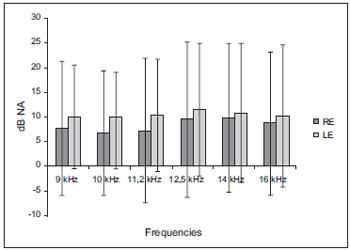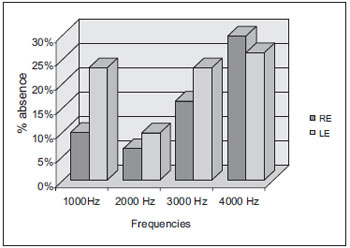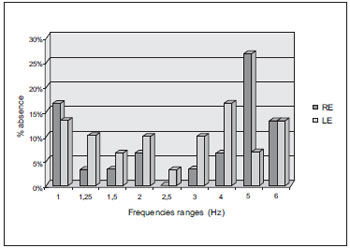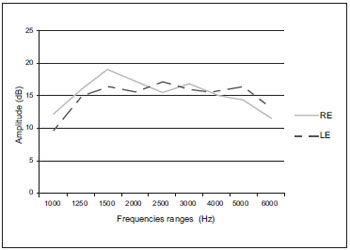INTRODUCTIONToday one of the scientific production themes in the area of audiology and environment health is the noise in leisure activities and the risks to hearing (1). Therefore, the phonoaudiology has been superseding the clinical and therapeutic limits and leading its work to preventive actions.
Nowadays we live in a noisy world, we are exposed to high sound pressure levels in some work places, in the streets and in leisure activities, specially when it comes to the younger population.
The exposure to music has become a subject for studies among the specialists in hearing and acoustics, since this exposure is related to the professional and social activity. The exposure pursuant to amplified music leads to auditory fatigue, the temporary change of the hearing threshold is only one of its manifestations (2-4) and may be associated to the sound perception, reduction of the frequency selectivity, temporal resolution as well as the space resolution in some sound levels (5); such exposure may cause discomforts such as stress (6-7) and auditory problems that range from a simple headache to a noise-induced hearing loss.
Certain studies have verified the noise intensity present in night clubs and concluded it may cause hearing loss, once the present noise intensity ranged from 78dB to 111dB NPS (8) and from 96 dB to 103dB NPS (9), which exceed safe levels. A great acoustic discomfort environment and hearing loss risks for orchestra musicians was found where the sound levels indicated an average of 90 dB(A), with peaks reaching 110dB(A) (10).
The time of exposure and the intensity to which the individual is exposed are directly related to the hearing loss. As the PAIR evolves, the individual begins to report the difficulty to understand the speech, specially in the presence of noisy environments. Non-auditory symptoms may also be present, such as buzz, irritation, dizziness, headache, gastric disorders, sleep disturbance, concentration capacity reduction and others (11).
Nowadays, the interest in the early diagnosis of auditory changes has been increasing due to the fact the corticopathy quickly affects the hair cells, responsible for the sound transduction, and taking into account the researches indicate the presence of auditory changes in the absence of complaints, that are not commonly detected in the conventional audiologic battery of tests, other methods have been used to identify auditory alterations early.
According to studies performed, the (AT-AF) High Frequencies Tonal Audiometry consists of an instrument for the early diagnosis of auditory changes coming from some etiologic agents such as ageing, exposure to ototoxic drugs and occupational noise.
Aiming at checking the AT-AF application in the PAIR's early diagnosis, a study (12) examined a thousand workers with record of intense noise exposure, with intensity ranging from 95 to 115 dB NPS. It was confirmed that the changes in the threshold of the high frequencies (10kHz to 20kHz) occurs before the low frequencies (500Hz to 6kHz).
Considering the exposure to high levels of sound pressure is frequent in this profession, it's important to research the existence of auditory changes traces in this population. Thus, the objective of this study was to investigate the musicians auditory health as well as review what is the method with a greater sensitivity for the early diagnosis of auditory changes.
METHODThe study was accomplished in a Phonoaudiology clinic and was approved by the Ethics Committee in Research of the Organization where it was performed, according to process no. 159/2004 and all participants signed a Free and Clear Authorization Term.
The criteria established for inclusion of participants in the sample were: individuals who acted in the profession of musician for more than 2 years; musicians who were exposed to noise levels equivalent or higher than 85 dBNPS, which were verified by means of the environmental noise measurement; individuals aged between 18 and 40 years. As an exclusion criterion, we determined: presenting neurological, psychiatric and/or cardiac problems; using ototoxic medication; presenting hearing deficiency with determined etiology.
The criteria used for exclusion of the sample individual were obtained by means of specific interview.
As procedures for this work the noise level evaluation in the working place and the participants' audiologic evaluation were adopted.
For the evaluation of the noise level in the working place, the sound pressure level meter INSTRUTERM, model DEC 405, was used and calibrated before each measuring session and it was freed from possible errors caused by temperature variation or atmospheric pressure and adjusted in the weighting curve "A", slow response, according to technical norm recommended (13).
All measurements were made in decibel (dB(A)), with the equipment placed at a distance of approximately 15 centimeters from the participants' ears. Such measuring was carried out by a specialized technician and occurred after prior request of authorization by the responsible for the establishments where the workers remained. The measurements were carried out and in all places a noise level higher than 85 dBNPS was obtained.
For the audiologic evaluation, the participants were advised to make an auditory rest of 14 hours. The following proofs were applied: specific interview, external auditory meatus clinical inspection, tympanometry, (AT-AC) conventional threshold tonal audiometry, logoaudiometry, (AT-AF) high frequency tonal audiometry and otoacoustic emissions.
In the specific interview, we performed a survey of identification data, family antecedents, Hearing Impairment risk indicators, general and auditory health, occupational environment, leisure habits, medication use etc.
The external auditory meatus clinical inspection was made to check for obstacle on the performance of the specific proofs.
The tympanometry was made to check the middle ear state. An imitanciometer Siemens model SD 30 was used.
In the conventional threshold Tonal Audiometry, we carried out a research on the auditory threshold in the frequencies of 250, 500, 1000, 2000, 3000, 4000, 6000, 8000 Hz, for the right and left ears. We used warble tone. The audiometry results were analyzed according to the ranking proposed in the literature (14), normal, equal thresholds or lower than 25 dB; normal with incision: lowering in one of the frequencies of 3, 4 or 6kHz; PAIR suggestive tracing: although the thresholds are still above 25 dB, there is a lowering in the frequencies of 3, 4 or 6kHz; others: with thresholds greater than 30 dB in some frequency that doesn't correspond to the PAIR suggestive tracing.
In the logoaudiometry we researched the (SRI) speech recognition index by means of words list and (SRT) speech recognition threshold.
In the high frequency tonal audiometry we researched the auditory threshold in the frequencies of 9000, 10000, 11200, 12500, 14000 e 16000 Hz, for the right and left ears. We used warble tone. For AT-AC, logoaudiometry and AT-AF we used audiometer, Siemens make model SD 50, with earphone HAD 200.
The otoacoustic emissions test was carried out in acoustically treated rooms by means of the
Otodynamics Ltda ILO 292 Research OEA System equipment, aiming at evaluating specifically the external hair cells through the presence or absence of the responses record. The criterion used for the presence of (EOE-T) transient stimulus evoked otoacoustic emission was that proposed in the literature (15), deemed to be present where the general reproducibility was larger or equal to 50% with response amplitude, signal/noise relation, larger or equal to 3 dBNPS in at least three consecutive frequencies evaluated and probe stability higher than 80%. The record absence was also separately reviewed by frequency range, that is, where there was absence in at least one of them. The EOE-T's' research was made in the frequency ranges of 1000, 2000, 3000 and 4000 HZ. The stimulus was of non-linear click type with adequate intensity between 79 and 83 dB NPS. The (EOE-DP) distortion product evoked otoacoustic emissions records were studied considering the responses occurrence and amplitude. By presenting 2 pure tones simultaneously, with different frequencies (f1 and f2) and respecting the relation f1/f2= 1.22, the stimuli intensities met the relation L1 = 65 dB NPS and L2 = 55 dB NPS. The response DP1 (2f1-f2) was considered present where the emission amplitude exceeded 6 dB the noise level (S/N
> 6 dB).
As statistical methods we used the Spearman correlation coefficient, Friedman's test and Wilcoxon's test. The Spearman correlation coefficient was computed considering age, time in the profession and time of daily exposure with the audiometric thresholds in the different frequencies researched. The Friedman's test was used for comparison between the tonal thresholds in order to check for any frequency that could be more affected. The Wilcoxon's test was used for comparison between the tonal thresholds obtained in the high frequencies between the right and left ears. In the abovementioned statistical tests we adopted a level of significance equal to 0.05.
RESULTSThe casuistics of this study was composed by 30 participants of both genders, 27 of male sex and 3 of female sex with a minimal age of 18 year and maximal age of 37 (average: 25.2 years and standard deviation: 5.19 years).
As far as the beginning of the professional activity is concerned, 3 participants (10%) informed they began their professional activity in less than 5 years, 13 participants (43.33%) mentioned a duration of work from 5 to 10 years and 14 participants (46.66%) have worked for more than 10 years. The professional activity time average was of 9.1 years, with a standard deviation of 3.76 years.
When we researched the daily time exposure to amplified music, 13 participants (43.3%) informed they are exposed between 1 and 4 hours, 11 participants (36.6%) stated the daily exposure is between 4 to 7 hours and 6 participants (20%) with exposure time between 7 to 10 hours. The participants' average daily exposure is 4.7 hours and standard deviation of 2.24.
The specific interview data analysis confirmed that regarding the noise subjective sensation, 100% of the participants informed they work in highly noisy places. Although they considered the working place to be noisy, the discomfort caused by the noise was not frequent. When we asked about the occurrence of the auditory complaint type, the participants' mostly mentioned symptom was buzz, followed by the difficulty of understanding speech in noisy environments.
As to the level of recognition on the auditory loss in the work, 100% of the participants were aware of this, however they could only say it was harmful for the hearing.
In the external auditory meatus clinical inspection, all of them were able to make specific proofs.
We obtained a record of type A tympanometric curve, bilaterally in 100% of the participants, which indicated, however, the middle ear didn't interfere with the results obtained.
In the conventional threshold tonal audiometry, the review was made according to the classification proposed in the literature (14), and it distributed the cases as follows: 69% of the participants had normal hearing, 17% had a PAIR suggestive audiogram, followed of 7% of the participants who presented a normal audiogram with incision and 7% with other configurations.
Such results were also analyzed as to the averages of frequencies of 500, 1.000 and 2.000 Hz and 3.000, 4.000 and 6.000 Hz, aiming at checking for a lowering in the highest frequencies, as recommended (16-7). These data may be observed in Chart 1.

Chart 1. Average ± 1 standard deviation of the right and left ears tonal thresholds in ATL for the frequencies of 500 Hz, 1000 Hz and 2000Hz (Average I) and 3000 Hz, 4000Hz and 6000 Hz (Average II). - ATL: Threshold Tonal Audiometry RE: right ear LE: left ear.
The logoaudiometry made by means of the LRF confirmed the tonal audiometry results by respiratory passages in all the participants, and the IRF also presented results compatible with the threshold found in all participants.
Chart 2 shows the average and standard deviation in the tonal thresholds in AT-AF for OD and OE.

Chart 2. Average ± 1 standard deviation of the tonal threshold in AT-AF for the right and left ears. - AT-AF: High Frequencies Tonal Audiometry RE: right ear LE: left ear.
Upon research of the correlation between the participants' age and the tonal thresholds in high frequencies, we observed a positive and significant correlation in the frequencies of 12.500 Hz (OD: r= 0,506 p= 0,004; OE: r= 0,478
p= 0,008), 14.000 Hz (OD: r= 0,706 p= 0,000; OE: r= 0,563 p= 0,001) and 16.000 Hz (OD: r= 0.679 p= 0,000; OE: r= 0,614 p= 0,000) for both ears. When the correlation was researched between the time of profession and the audiometric thresholds of high frequencies, we observed a positive and significant correlation in the frequency of 16.000 Hz for both ears (OD: r= 0.395 p= 0.031; OE: r= 0,381 p= 0,038). In the correlation between the daily exposure to muse and the tonal thresholds, there was no significant result confirmed.
Upon investigation by means of the Friedman's test of any frequency evaluated with a great affection, we observed insignificant results.
By using the Wilcoxon's test we compared the high frequencies audiometric thresholds between the ears and observed a significant difference between the ears in the frequencies of 10.000Hz (p=0,017) and 11.200Hz (p=0,009).
In the otoacoustic emissions test we tested the EOE-T and EOE-DP and observed 26.7% (n=8) of absence of EOE-T for OD and 23.3% (n=7) for OE. And the emissions absence occurred mainly in the frequency range of 3 and 4 kHz, as described in Chart 3. in the EOE-DP research we confirmed absence of emissions in 15 participants only in isolated frequencies, with a higher prevalence of such absence in the frequencies of 4, 5 and 6kHz, as shown in Chart 4. Chart 5 shows the average amplitude of the EOA-DP pursuant to the frequencies ranges researched.

Chart 3. Prevalence of the EOE-T Absence according to the frequencies reviewed. - EOE-T: Transient evoked otoacoustic emission RE: right ear LE: left ear.

Chart 4. Prevalence of the EOE-DP Absence in the frequencies analyzed. - EOE-DP: Distortion product evoked otoacoustic emissions RE: right ear LE: left ear.

Chart 5. Average of EOE-DP's amplitude pursuant to the frequencies ranges for the right and left ears. - EOE-DP: Distortion product evoked otoacoustic emissions RE: right ear LE: left ear.
In this study we investigated the musicians auditory accuracy, where we could observe, before the results obtained by means of exams, this population run a high risk to develop hearing loss induced by high sound pressure levels. The conventional audiometry results showed that 17% had PAIR suggestive audiogram, followed by 7% with normal audiogram with incision and 24% of the sample presented characteristics of a possible PAIR development.
Upon review of the threshold obtained in the frequencies of 500, 1000 and 2000 Hz with the threshold average of 3000, 4000 and 6000 Hz, according to recommendations (16-7), we observed that the higher frequencies thresholds average is more lowered than the average of the thresholds found in the lowest frequencies (18-9). On AT-AF, although the average of the thresholds found were of at most 11 dBNA, we could observe an incision in the frequency of bilateral 12.5000Hz and in the frequency of 14.000Hz in the right ear and such result is similar to those in the literature (7). As shown in Chart 2, the standard deviation of this review was described with high values because the participants' thresholds were obtained with a great inter-subjects variability, that is, we found thresholds within normality standard (minimum: 0 dBNA) as well as the lowered thresholds (maximum: 65 dBNA) in a certain frequency. Since the high frequencies audiometry thresholds average is lower than the conventional audiometry thresholds average, such result may suggest a beginning of affection in such frequencies due to exposure to high levels of sound pressure.
The positive and significant correlation found in the relation of the participants' age to the high frequencies audiometric thresholds indicates that the older the participant is the worse the audiometric thresholds are, which confirms the literature data (20-1). As to the correlation between the profession time and the high frequencies audiometric thresholds, in which we obtained a positive and significant correlation, we confirmed that the longer the individual experience in this profession is, being exposed to high levels of sound pressure, the worse is the audiometric threshold (7, 18, 21).
In the EOAs record, the most notorious benefit is its capacity to inspect objectively, and not invasively, the external hair cells functionality. This cellular receptor important susceptibility to the viral and bacterial diseases adverse effects, the genetic changes, external agents, such as intense sounds, ototoxic and chemical drugs that damage hearing is well known. The extraordinary selective and sensitive property of "lesion location" from the responses issued is what encouraged the researchers to develop such procedures into methods of clinical utility for the approach of the hearing process' initial phases (22).
In this study, upon performance of the EOE-T record we found 26.7% of absence for OD and 23.3% for OE, and the frequencies of 3 and 4 kHz presented the highest absence rate, as well as we found in the literature (23). In the EOS-DP's research we confirmed absence of emission in 15 participants only in isolated frequencies, with a larger predominance of such absence in the frequencies of 4, 5 and 6kHz. This may indicate a greater affection of external hair cells in the frequency range between 3 and 6 kHz, probably due to the exposure of these patients to high sound pressure levels (and"85 dBNPS) in the working place, which differ from the literature statements (24).
The otoacoustic emission may be applied to auditory conservation programs with proposal for early detection of the hearing damage caused by occupational exposures (22, 25-7).
In this work we confirmed that even in the absence of auditory complaints, the audiometric thresholds being in the normality range, the absence of EOE-T and EOE-DP records are present such statement may indicate the beginning of a PAIR, since their absence is more evident in the highest frequencies, which are mostly affected by noise exposure.
CONCLUSIONBefore the statements of this study, we may conclude in this population we could confirm: changes in the tests carried out in the absence of auditory complaint; the test of otoacoustic emissions both evoked by transient stimulus and by distortion product offered a greater sensitivity in the early detection of auditory changes; musicians run a significant risk of developing PAIR. Hence the importance of developing an auditory health program is critical to satisfy this population.
BIBLIOGRAPHICAL REFERENCES1. Morata TC. Young people: Their noise and music exposures and the risk ofhearing loss. Int J Audiol. 2007, 46:111-2
2. Bray A, Szymanski M, Mills R. Noise induced hearing loss in dance music disc jockeys and an examination of sound levels in nightclubs. J Laryngol Otol. 2004, 118(2):123-8
3. Santos L, Morata TC, Jacob LC, Albizu E, Marques JM, Paini M. Music exposure and audiological findings in Brazilian disc jockeys (DJs). Int J Audiol. 2007, 46:223-31
4. S
chmuziger N, Patscheke J, Probst R. An Assessment of Threshold Shifts in Nonprofessional Pop/Rock Musicians Using Conventional and Extended High-Frequency Audiometry. Ear Hear. 2007, 28(5):643-8
5. Paniz SIM. Caracterização dos níveis de pressão sonora em danceterias e avaliação auditiva de jovens freqüentadoras. Em: Caminhos para a saúde auditiva, ambiental e ocupacional. São Paulo: Plexus Editora; 2005, p. 12.
6. Kähäri K, Zachau G, Eklöf M, Möller C. The influence of music and stress on musicians' hearing. J Sound Vibration. 2004, (277):627-31
7. Kazkayasi M, Yetiser S, Ozcelik S. Effect of Musical Training on Musical Perception and Hearing Sensitivity: Conventional and High-Frequency Audiometric Comparison. J Otolaryngol. 2006, 35(5):343-8
8. Fernandes JC, Fernandes SR, Melchior M, Gomes MZ, Eilkmeier A. Medição do Nível de Ruído das Casas Noturnas de Bauru. Anais do XI Encontro Internacional de Audiologia; 1996, p.136; Bauru, Brasil.
9. Regazzi RD. Ruído no interior de casas noturnas. Rio de Janeiro, 1996; disponível em: www.isegnet.com.br/colunistas/coluna_regazzi2.htm. Acessado em 20 de dezembro de 2007.
10. Fernandes JC, Soleman C, Watanabe EE, Carlino FC, Kayamori F, Ferreira FB et al. Avaliação do Risco de Perda Auditiva em Músicos. Anais do XI SIMPEP, UNESP, 2004; Bauru, Brasil.
11. Beltrami, CHB. Perda Auditiva Induzida pelo Ruído. (monografia apresentada ao Curso de Especialização em Fonoaudiologia da Escola Paulista de Medicina). São Paulo, 1992.
12. Wang Y, Yang B, Li Y, Hou L, Hu Y, Han Y. Application of extended high frequency audiometry in the early diagnosis of noise-induced hearing loss. Zhonghua Er Bi Yan Hou Ke Za Zhi. 2000, 35(1):26-8.
13. ABNT - Associação Brasileira de Normas Técnicas. Norma 10.151, 1987.
14. Fiorini AC. Conservação Auditiva: estudo sobre o monitoramento audiométrico em trabalhadores de uma indústria metalúrgica [dissertação]. São Paulo: Pontifícia Universidade Católica de São Paulo; 1994.
15. Prieve BA, Gorga MP, Schimidt A, Neely S, Peters J, Schultes P et al. Analysis of transient-evoked otoacoustic emissions in normal-hearing and hearing-impaired ears. J Acoust Soc Am. 1993, 93(6):3008-19.
16. Comitê Nacional de Ruído e Conservação Auditiva - Recomendações para a avaliação dos prejuízos ocasionados pela Perda Auditiva Induzida pelo Ruído, Carta aos editores, Acta AWHO. 1996, 16:45
17. The National Institute for Occupational and Safety Health - NIOSH - [site na internet] Disponível em: http://www.cdc.gov/niosh. Acessado em 15 de junho de 2008.
18. Juman S, Karmody CS, Simeon D. Hearing loss in steelband musicians. Otolaryngol Head Neck Surg. 2004, 131(4):461-5.
19. Schmuziger N, Patscheke J, Probst R. Hearing in Nonprofessional Pop/Rock Musicians. Ear Hear Aug. 2006, 27(4):321-30
20. Groh D, Pelanova J, Jilek M, Popelar J, Kabelka Z, Syka J. Changes in otoacoustic emissions and high-frequency hearing thresholds in children and adolescents. Hear Res. 2006, (212): 90-8.
21. Hoffman JS, Cunningham DR, Lorenz DJ. Auditory thresholds and factors contributing to hearing loss in a large sample of percussionists. Med Probl Perform Art. 2006, 21(2):47-58.
22. Gattaz G, Wazen SRG. O Registro das Emissões acústicas Evocadas - Produto de Distorção em Pacientes com Perda Auditivia Induzida pelo Ruído. Rev Bras Otorrinolaringol. 2001, 67(2):213-8.
23. Mansfield JD, Baghurst PA, Newton VE. Otoacoustic emissions in 28 young adults exposed to amplified music. Br J Audiol. 1999, 33(4):211-22.
24. Pride JA, Cunningham DR. Early evidence of cochlear damage in a large sample of percussionists. Med Probl Perform. 2005, 20(3):135-9.
25. Vinck BM, Van Cauwenberge PB, Leroy L, Corthals P. Sensitivity of transient evoked and distortion product otoacoustic emissions to the direct effects of noise on the human cochlea. Audiology. 1999, 38(1):44-52.
26. Balatsouras DG. The evaluation of noise-induced hearing loss with distortion product otoacoustic emissions. Med Sci Monit. 2004, 10:218-22.
27. Shupak A, Tal D, Shakoni Z, Oren M, Ravid A, Pratt H. Otoacoustic Emissions in Early Noise-Induced Hearing Loss. Otol Neurotol. 2007, 28(6):745-52.
1. Graduation in Phonoaudiology. In course for specialization in Clinical Audiology.
2. Doctor's degree. Doctor Professor.
3. Specialist in Clinical and Educational Audiology. In course for Master's Degree in General Bases of Surgery/UNESP-Botucatu.
4. Master's Degree in Phonoaudiology by FOB/USP. Fapesp's Scholarship Holder
5. Doctor's Degree. Associated Professor.
Institution: Phonoaudiology Department - Odontology College of Bauru - University of São Paulo.Bauru / SP - Brasil.
Mail address:
Andréa Cintra Lopes
Alameda Dr. Octavio Pinheiro Brisolla, 9-75 - Vila Universitária
Bauru / SP - Brazil - Zipcode: 17043-101 - Caixa Postal: 73
E-mail: aclopes@usp.br
Financial support: Fapesp - São Paulo State Research Agency Process: 2006/01215-7.
Article received on July 9, 2008.
Approved on October 13, 2008.